
Robotic component loading and unloading has given Hemlock Engineering a five-fold increase in production output on its latest 5-axis machining centre compared to manually loaded machines.
The new Brother 5-axis, 30-taper Speedio M200X3 vertical-spindle machining centre achieved this on relatively small batches of components between 1,000- and 2,000-off requiring short cutting cycles of between two and 10 minutes, a combination that necessitates frequent changeover of the production cell.
Hemlock's owner Paul Cobb had exact figures to hand when interviewed. He said, "Typically, one of our 40-taper VMCs runs for 40 hours per week. However, a lot of the time the relatively slow spindle is not cutting – I estimate we get on average 45% utilisation. With the robotic Feedio load / unload system serving the latest Brother, we achieve 100 hours operation per week, sometimes more, and the uptime of the faster 30-taper spindle is 88%.
"On this basis, overall production output is about five times that of one of our 40-taper machines. Additionally, the latter capacity needs the full-time attendance of an operator whereas the Brother cell occupies an operator for only about 20% of the person's time. So there is a five-fold reduction in the labour cost content of components produced."
He explained that the plug-and-play Speedio / Feedio cell costs about £800 per week to run including finance, labour and power, which he said "is not very much". It arrived on the shop floor in March 2022 and, as already observed, produces similar output to five 40-taper machines with full-time operators. That is why Mr Cobb describes the benefits of his first ever automated prismatic component production cell as "absolutely astronomical" and "off the charts".
What makes automation feasible for small batches of relatively uncomplicated components requiring short cycle times is rapid cell changeover within two hours, including swapping the cutting program and tools. This is largely down to Brother's easy-to-use ChipLite conversational software that controls the handling robot and camera vision system.
Mr Cobb said that changing over a conventional robot-loaded machining centre and reprogramming it would take days rather than hours.
As to his choice of automated handling of the component itself, rather than a machine pallet with a component fixtured, Mr Cobb pointed to the couple of hundred different jobs routinely passing through his factory that are able to benefit from automation. They would need expensive pallets and bespoke jigs and fixtures, a production route that would not be economical. Furthermore, the footprint of such pallet change systems tends to be large.